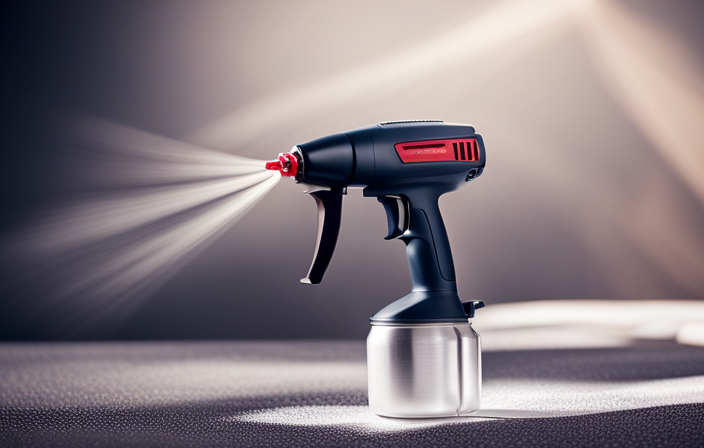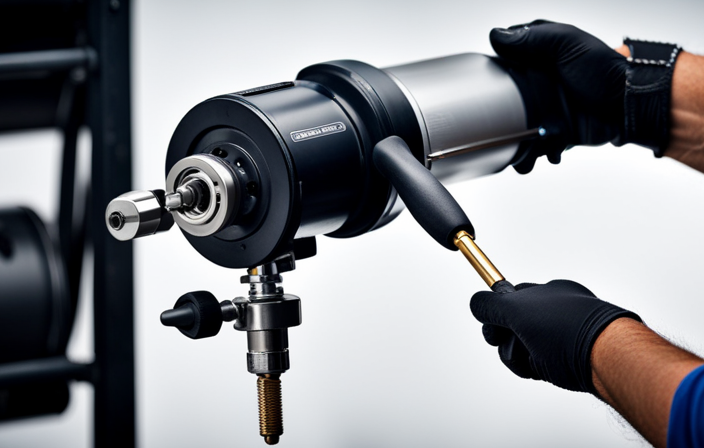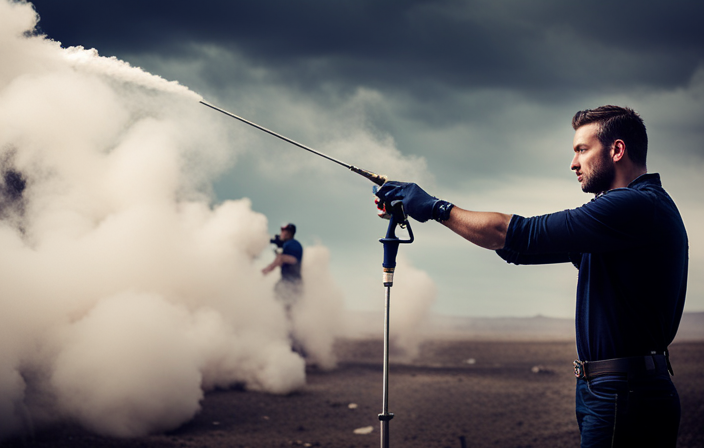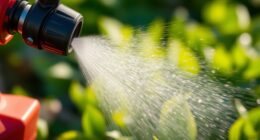When it comes to painting an iron fence, using an airless sprayer is one of the best methods for achieving a fast and flawless finish. This tool is powerful and ensures a smooth coat of paint in no time.
In this article, I will guide you through the step-by-step process of spray painting your iron fence using an airless sprayer.
- Prepare your fence and choose the right paint.
- Master the spraying technique.
- Maintain your equipment.
Preparing your fence and choosing the right paint is crucial for a successful paint job. Make sure to clean the fence thoroughly and remove any rust or loose paint. Additionally, choose a high-quality paint that is specifically designed for metal surfaces.
Mastering the spraying technique is essential to achieve a professional-looking finish. Start by practicing on a scrap piece of metal to get a feel for the sprayer. Hold the sprayer at a consistent distance from the fence and move it in a smooth and steady motion. Overlapping each pass by 50% will ensure even coverage.
Maintaining your equipment is important to prolong its lifespan and ensure optimal performance. Clean the sprayer thoroughly after each use to prevent clogs and buildup. Check and replace any worn or damaged parts as needed.
Whether you’re a DIY enthusiast or a seasoned painter, this article will equip you with the knowledge and skills to transform your iron fence and give it a fresh, vibrant look. So let’s get started and make your fence the envy of the neighborhood!
Key Takeaways
- Achieving a smooth finish requires allowing paint to dry completely and avoiding touching or disturbing the paint.
- Allowing sufficient time for full cure is important for durability, and rushing can compromise the final result.
- Inspecting and touching up the fence is necessary to fix any imperfections and ensure even coverage.
- Regularly cleaning and maintaining the sprayer is crucial to prevent clogs and unexpected problems during the painting process.
Prepare Your Fence for Painting
Before you start spray painting your iron fence with an airless sprayer, make sure to properly prepare it to achieve a flawless and long-lasting finish.
Begin by gathering the necessary tools for preparing the fence, such as a wire brush, sandpaper, and a pressure washer. These tools will help you remove any existing rust, dirt, or loose paint from the surface of the fence.
Start by using the wire brush to scrape off any loose rust or paint, then sand the entire surface to smooth out any rough areas.
Once the surface is clean and smooth, use a pressure washer to thoroughly clean the fence and remove any remaining dirt or debris. This will ensure that the paint adheres properly to the surface.
With the fence prepped and ready, you can now move on to choosing the right paint and equipment for the job.
Choose the Right Paint and Equipment
To properly coat your iron fence, make sure you select the correct type of paint and use the appropriate equipment. When choosing paint colors for your iron fence, it’s important to consider both aesthetic preferences and the durability of the paint. Opt for a high-quality exterior paint that is specifically designed for metal surfaces. Look for paints that offer protection against rust and UV damage. Additionally, consider the color of your fence and its surroundings to ensure a harmonious look. As for equipment, an airless sprayer is the best choice for painting an iron fence. It provides a smooth and even finish, saving you time and effort. Remember to maintain your equipment properly by cleaning it thoroughly after each use and storing it in a dry place. With the right paint and equipment, you’ll be well on your way to a beautifully painted iron fence. In the next section, we’ll discuss how to set up your work area.
Set Up Your Work Area
To ensure a clean and efficient painting process, it’s essential to cover surrounding areas with drop cloths or plastic sheets. This will protect them from overspray.
Additionally, it’s important to set up a dedicated work table for your paint and equipment. This will provide a stable and organized space to work from.
Having a dedicated work table will help prevent accidental spills and keep everything within easy reach. It will allow for a seamless painting experience.
Cover Surrounding Areas to Protect from Overspray
When using an airless sprayer to spray paint the iron fence, it is important to be careful and avoid splattering paint on the surrounding areas. To prevent overspray, protective measures should be taken. First, cover any nearby objects or surfaces that you don’t want to be painted. This can be done using drop cloths or plastic sheets to protect the ground, plants, and any other items in the vicinity. Make sure to secure the covers in place to prevent them from moving during the painting process. Pay special attention to areas directly adjacent to the fence to avoid accidental splatters. By taking these precautions, you can minimize the risk of overspray and maintain a clean work area. Once the surrounding areas are protected, you can proceed to set up a work table for paint and equipment.
Set Up a Work Table for Paint and Equipment
Once you’ve ensured proper protection for the surrounding areas, it’s time to set up a work table for your paint and equipment. A well-organized work table setup is crucial for a smooth and efficient spray painting process.
Start by selecting a sturdy table that can support the weight of your equipment and materials. Place the table in a well-ventilated area, away from any potential hazards.
Next, organize your equipment in a logical manner. Keep the paint cans, spray gun, and other tools within easy reach. Consider using containers or trays to keep smaller items organized.
Make sure to have an adequate supply of clean rags, paint brushes, and other necessary accessories nearby. Having everything you need within arm’s reach will help minimize delays and maximize productivity.
By having a well-planned work table setup and equipment organization, you can set yourself up for success in the painting process.
Practice Proper Spraying Technique
Mastering the art of spray painting an iron fence with an airless sprayer requires you to develop proper spraying technique. To achieve a smooth and even finish on your iron fence, it is essential to consider different weather conditions.
In hot and dry weather, you should spray paint early in the morning or late in the evening to avoid rapid drying and potential streaking. On the other hand, in cold weather, it is crucial to warm up the paint and the sprayer before starting.
Additionally, keep the sprayer at a consistent distance from the fence, usually around 8-12 inches, and move it in a steady, overlapping motion. This technique ensures an even coat and minimizes drips or runs.
With these proper spraying techniques in mind, you are ready to start painting your iron fence, transforming it into a beautiful and protected structure.
Start Painting Your Fence
Now it’s time for you to begin transforming your fence into a beautiful and protected structure. When painting your fence, proper maintenance is crucial to ensure its longevity.
Start by choosing the right paint for the job. Look for a high-quality paint that is specifically designed for outdoor use and can withstand the elements. Additionally, consider the color and finish that will best complement your property.
Once you have the paint, prepare the fence by cleaning it thoroughly and removing any rust or old paint. Use an airless sprayer to apply the paint evenly and efficiently. Remember to follow the manufacturer’s instructions for mixing and spraying the paint.
After painting, allow the paint to dry and cure before moving on to the next step of fence maintenance.
Allow the Paint to Dry and Cure
When allowing the paint to dry and cure on your fence, it’s important to follow the recommended drying time provided by the manufacturer. This will ensure that the paint fully adheres to the surface and prevents any potential damage.
It’s crucial to avoid touching or disturbing the paint during this drying period, as it can cause smudges or unevenness in the finish.
Additionally, allowing sufficient time for the paint to fully cure will result in a durable and long-lasting coating that can withstand the elements and maintain its appearance over time.
Follow the Recommended Drying Time
To ensure a flawless finish, wait for the recommended drying time before touching your freshly spray-painted iron fence with an airless sprayer. The recommended drying time varies depending on the type of paint and environmental conditions. It is crucial to follow this guideline to avoid smudging or ruining the finish.
Rushing the drying process can result in a less durable and less attractive paint job. If the paint is not fully dry, it may peel or chip easily, compromising the overall appearance and longevity of the fence. Patience is key when it comes to achieving a smooth finish.
Once the recommended drying time has passed, you can proceed to the next step without worrying about touching or disturbing the paint.
Avoid Touching or Disturbing the Paint
Be careful not to rock the boat and ruin the fresh coat of paint on your iron fence. When spray painting with an airless sprayer, it is crucial to avoid touching or disturbing the paint until it has fully dried.
This is essential for avoiding damage and preventing paint smudges. Even the slightest touch can leave unwanted marks or fingerprints on the surface. To ensure a flawless finish, resist the temptation to inspect or interact with the painted fence until it has had sufficient time for full cure.
Patience is key in allowing the paint to harden completely. Once the paint has fully cured, you can move on to the next step of the process, which involves allowing sufficient time for full cure.
Allow Sufficient Time for Full Cure
Take a moment and imagine the satisfaction of admiring your freshly painted iron fence. But remember, it’s important to allow sufficient time for the paint to fully cure and harden before moving on to the next step.
The full cure time for spray paint can vary depending on the specific product and environmental conditions. Typically, it ranges from 24 to 48 hours. Patience is key during this stage. Rushing the process can result in a less durable finish that is prone to chipping and peeling.
Allow the paint to dry completely before inspecting and touching up any areas that may need it. Once the paint has fully cured, you can move on to the next section where we will discuss how to inspect and touch up as needed.
Inspect and Touch Up as Needed
Inspect the iron fence carefully and fix any imperfections you find by using an airless sprayer. This will help you achieve a flawless finish that is sure to impress!
When inspecting, make sure to use proper techniques such as examining the fence from different angles and checking for any missed spots or uneven coverage. If you notice any areas that require touch-up, grab your touch-up tools and apply a thin layer of spray paint to those spots.
Be sure to blend the touch-up paint seamlessly with the rest of the fence. This meticulous attention to detail will ensure a professional-looking result.
Once you have inspected and touched up the fence, it’s time to move on to the next step and clean and maintain your sprayer, so it’s ready for future projects.
Clean and Maintain Your Sprayer
Make sure you keep your sprayer in top-notch condition by regularly cleaning and performing maintenance tasks, so you can always achieve flawless results on your future projects. Here are some cleaning tips and troubleshooting common issues to help you maintain your sprayer:
- Clean the sprayer thoroughly after each use to prevent clogs and build-up.
- Use a brush or toothpick to remove any dried paint from the nozzle and other parts.
- Check the filters regularly and clean or replace them as needed to ensure proper paint flow.
By following these cleaning tips and troubleshooting common issues, you can prolong the lifespan of your sprayer and avoid any unexpected problems during your painting projects.
Now, you can move on to the next section and enjoy your newly painted iron fence.
Enjoy Your Newly Painted Iron Fence
Now that your iron fence has been freshly coated, it’s time to savor the transformation and admire the striking results.
To achieve a smooth finish, there are a few tips to keep in mind. Firstly, ensure that the airless sprayer is set to the correct pressure and that the paint is properly mixed. Start by spraying in a continuous motion, overlapping each pass slightly for even coverage. Avoid overspraying or applying too thick of a coat, as this can lead to drips and an uneven finish.
Additionally, be mindful of the weather conditions, as extreme heat or cold can affect the paint’s adhesion and drying time. Finally, take care to clean and maintain your sprayer after each use to prolong its lifespan.
By following these guidelines, you can avoid common mistakes and achieve a professional-looking result.
Now, let’s move on to sharing your experience and results.
Share Your Experience and Results
Take a moment to step back and admire the stunning transformation of your freshly coated iron fence, and share your experience and results with others. Here are some painting tips based on my experience:
-
Prep work: Thoroughly clean the fence to remove dirt and rust. Use sandpaper or a wire brush to smooth any rough spots.
-
Choose the right paint: Opt for a high-quality spray paint specifically designed for metal surfaces. This will ensure a smooth and durable finish.
-
Technique: Hold the airless sprayer about 12 inches away from the fence and apply the paint in even strokes. Start from the top and work your way down, overlapping each pass slightly.
-
Multiple coats: Apply multiple thin coats rather than one thick coat. This will prevent drips and ensure better coverage.
By following these painting tips, you’ll achieve professional-looking results. Share your experience and let others benefit from your newfound knowledge.
Frequently Asked Questions
How long does it usually take for the paint to dry and cure on an iron fence?
Typically, it takes about 24 hours for spray paint to dry on an iron fence. However, the curing process can take up to a week, depending on factors like temperature and humidity.
Can I use a regular paintbrush instead of an airless sprayer to paint my iron fence?
I can use a regular paintbrush instead of an airless sprayer to paint my iron fence. The pros of using a paintbrush are more control and precision, but it may take longer. The cons are a slower application and potential brush marks.
Are there any specific safety precautions I need to take when using an airless sprayer to paint an iron fence?
When using an airless sprayer to paint an iron fence, it’s important to prioritize safety precautions. Proper ventilation is crucial to avoid inhaling fumes, so make sure to work in a well-ventilated area or use a respirator.
What type of paint is best suited for painting an iron fence?
The best paint for an iron fence is a high-quality, rust-resistant enamel paint. It is available in a variety of colors to suit your preferences. Before painting, make sure to clean and prep the surface by removing any rust or dirt.
How often should I clean and maintain my airless sprayer to ensure its longevity?
To ensure your airless sprayer’s longevity, it’s wise to follow the adage "an ounce of prevention is worth a pound of cure." Regularly clean your sprayer after each use and perform routine maintenance practices to keep it in optimal condition.
Conclusion
Well, who would’ve thought that painting an iron fence could be so thrilling? Armed with my trusty airless sprayer, I embarked on a journey of transformation.
The iron fence, once dull and lifeless, now stands tall and proud, adorned in a fresh coat of vibrant paint. The smooth, even application achieved with the sprayer left me in awe. It was like watching a work of art come to life before my eyes.
Now, as I gaze upon my masterpiece, I can’t help but feel a sense of satisfaction and accomplishment.










